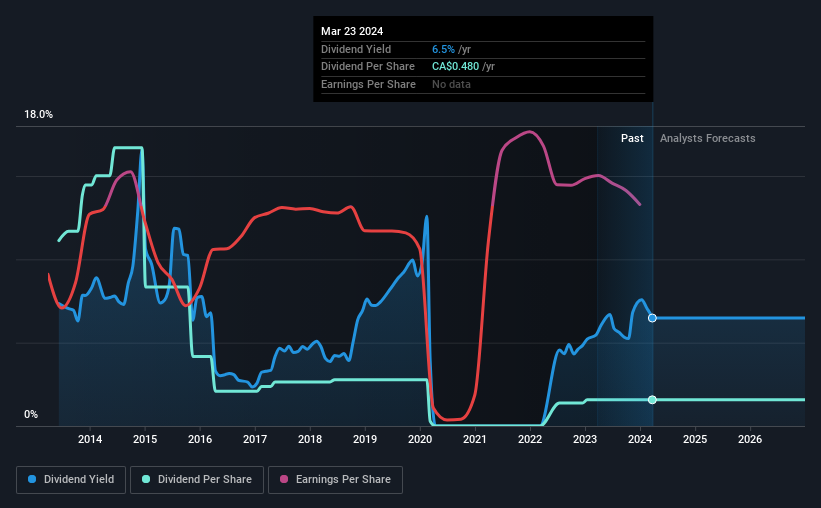Surge Energy Inc. (TSE:SGY) Stock Goes Ex-Dividend In Just Three Days
Readers hoping to buy Surge Energy Inc. (TSE:SGY) for its dividend will need to make their move shortly, as the stock is about to trade ex-dividend. The ex-dividend date is one business day before the record date, which is the cut-off date for shareholders to be present on the company's books to be eligible for a dividend payment. The ex-dividend date is important because any transaction on a stock needs to have been settled before the record date in order to be eligible for a dividend. Accordingly, Surge Energy investors that purchase the stock on or after the 27th of March will not receive the dividend, which will be paid on the 15th of April.
The company's next dividend payment will be CA$0.04 per share, on the back of last year when the company paid a total of CA$0.48 to shareholders. Looking at the last 12 months of distributions, Surge Energy has a trailing yield of approximately 6.5% on its current stock price of CA$7.41. Dividends are an important source of income to many shareholders, but the health of the business is crucial to maintaining those dividends. So we need to check whether the dividend payments are covered, and if earnings are growing.
Check out our latest analysis for Surge Energy
If a company pays out more in dividends than it earned, then the dividend might become unsustainable - hardly an ideal situation. An unusually high payout ratio of 301% of its profit suggests something is happening other than the usual distribution of profits to shareholders. Yet cash flow is typically more important than profit for assessing dividend sustainability, so we should always check if the company generated enough cash to afford its dividend. It paid out more than half (55%) of its free cash flow in the past year, which is within an average range for most companies.
It's good to see that while Surge Energy's dividends were not covered by profits, at least they are affordable from a cash perspective. If executives were to continue paying more in dividends than the company reported in profits, we'd view this as a warning sign. Very few companies are able to sustainably pay dividends larger than their reported earnings.
Click here to see the company's payout ratio, plus analyst estimates of its future dividends.
Have Earnings And Dividends Been Growing?
Businesses with strong growth prospects usually make the best dividend payers, because it's easier to grow dividends when earnings per share are improving. If business enters a downturn and the dividend is cut, the company could see its value fall precipitously. It's encouraging to see Surge Energy has grown its earnings rapidly, up 42% a year for the past five years.
Another key way to measure a company's dividend prospects is by measuring its historical rate of dividend growth. Surge Energy's dividend payments per share have declined at 18% per year on average over the past 10 years, which is uninspiring. Surge Energy is a rare case where dividends have been decreasing at the same time as earnings per share have been improving. It's unusual to see, and could point to unstable conditions in the core business, or more rarely an intensified focus on reinvesting profits.
The Bottom Line
Is Surge Energy an attractive dividend stock, or better left on the shelf? Surge Energy has been growing its earnings per share nicely, although judging by the difference between its profit and cashflow payout ratios, the company might have reported some write-offs over the last year. Overall, it's not a bad combination, but we feel that there are likely more attractive dividend prospects out there.
If you want to look further into Surge Energy, it's worth knowing the risks this business faces. For instance, we've identified 5 warning signs for Surge Energy (1 is potentially serious) you should be aware of.
If you're in the market for strong dividend payers, we recommend checking our selection of top dividend stocks.
Have feedback on this article? Concerned about the content? Get in touch with us directly. Alternatively, email editorial-team (at) simplywallst.com.
This article by Simply Wall St is general in nature. We provide commentary based on historical data and analyst forecasts only using an unbiased methodology and our articles are not intended to be financial advice. It does not constitute a recommendation to buy or sell any stock, and does not take account of your objectives, or your financial situation. We aim to bring you long-term focused analysis driven by fundamental data. Note that our analysis may not factor in the latest price-sensitive company announcements or qualitative material. Simply Wall St has no position in any stocks mentioned.

